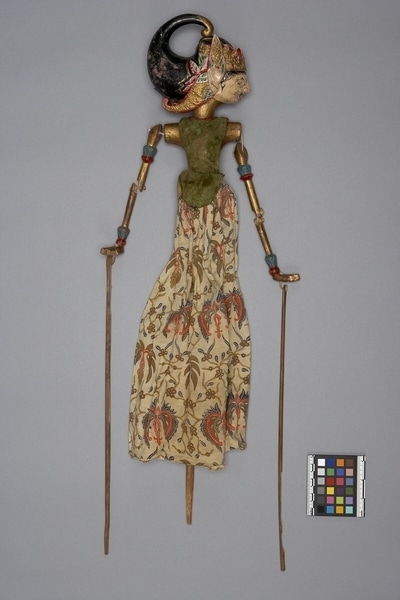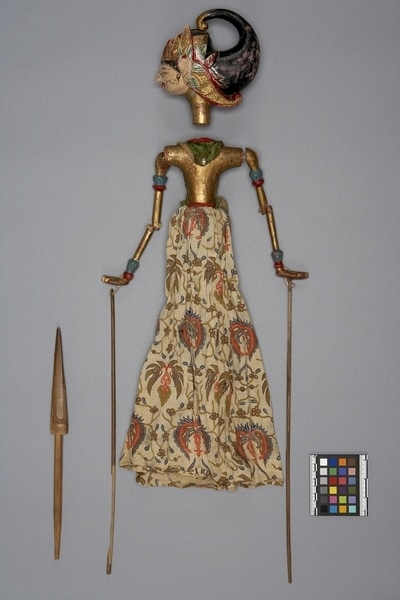Rod Puppet Item Number: Ib313 from the MOA: University of British Columbia


Description
Three-dimensional male humanoid puppet: large head (part b) fits into body with skirt (part a), and a control rod (part c) with a long shaft passes through the body and fits into the neck of the figure's head. The body has jointed arms, each with a long controlling rod attached. Figure has a large head and jointed arms attached to controlling rods. White face positioned forward. Gelung supit urang with Garuda Mungkur headdress: includes diadem (jamang), lungsen, and wide ear ornament (sumping) in black, gold, red, and green. Gold neck and body; torso slim with wide shoulders. Two ornaments on each arm at bicep and wrist; fingers held flat, hands bent back at wrist. Green velvet (synthetic?) chest covering, tacked to back; gold, blue, and orange patterned skirt.
History Of Use
Javanese puppetry as an art form probably developed by the 11th century. Wayang golek puppets of western Java appeared during the 16th century. Originally the plays depicted Javanese mythology, but after the Indian conquest of Java the Hindu epics, Ramayana and Mahabharata, were incorporated into the cycles, which comprise about 200 plays. A dalang (puppet master) performs the plays to celebrate important occasions, usually in three acts, with vocal and instrumental accompaniment. Typically they serve a moral and religious purpose, and more recently, one of political commentary. This puppet is likely a noble lord, whose role depends upon the cycle or play in which it appears, ranging form warrior to advisor. Irawan, a prince of the Mahabharata cycle, is the son of Arjuna, known for his nobility and also for impulsiveness.
Cultural Context
Theatrical performance.
Iconographic Meaning
Each puppet is characterized by it's wanda, a Javanese word which describes the specific mixture of elements of size, form, colour, ornamentation and carving. Headdress, white face, shape and size of body, and skirt indicate refinement and rank. Head facing forward seems to oppose this nobility. Gold skin found only on kings or characters of the highest nobility. Position of hands, and presence of arm ornaments suggest noble position. Character possibly a manifestation of noble character, such as Irawan. Angle of head is unusual, unless the puppet is a mood manifestation for anger or another emotional state. Not positively identified.
Item History
- Made in Java, Indonesia
- Owned by Tradewind Antiques before March 15, 1983
- Received from Museum of Anthropology Shop Volunteers (Funding source) and Tradewind Antiques (Seller) on March 15, 1983
What
- Name
- Rod Puppet
- Identification Number
- Ib313
- Type of Item
- puppet
- Material
- wood, fibre, synthetic fibre ?, metal, paint and cotton fibre
- Manufacturing Technique
- carved, painted, tied, sewn, tacked and woven
- Part A
- height 62.0 cm, width 18.0 cm, depth 6.5 cm
- Part B
- height 15.0 cm, width 8.0 cm, depth 14.5 cm
- Part C
- height 31.9 cm, width 2.4 cm, depth 1.4 cm
Who
- Culture
- Sundanese
- Previous Owner
- Tradewind Antiques
- Received from
- Museum of Anthropology Shop Volunteers (Funding source) and Tradewind Antiques (Seller)
Where
- Holding Institution
- MOA: University of British Columbia
- Made in
- Java, Indonesia
When
- Ownership Date
- before March 15, 1983
- Acquisition Date
- on March 15, 1983
Other
- Condition
- fair
- Accession Number
- 0886/0047